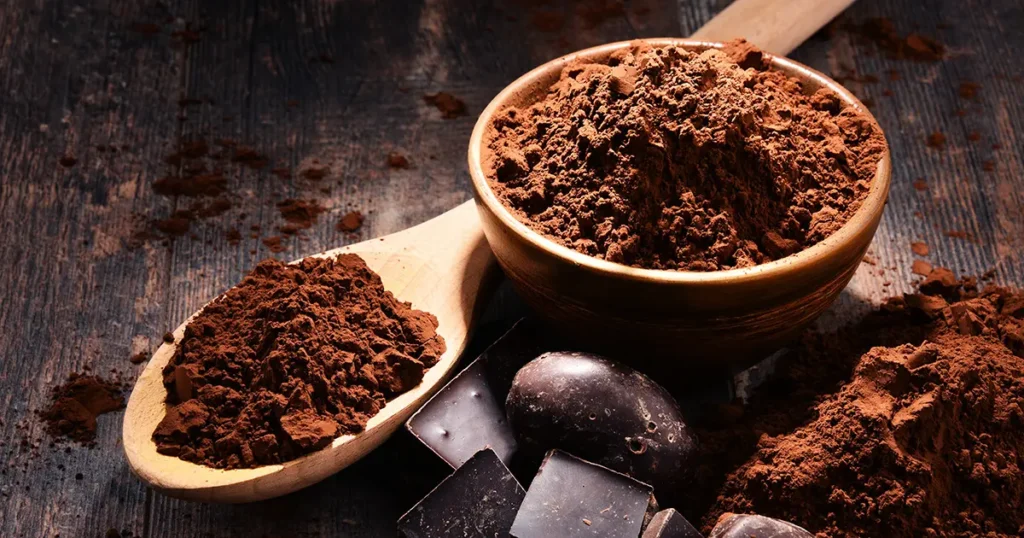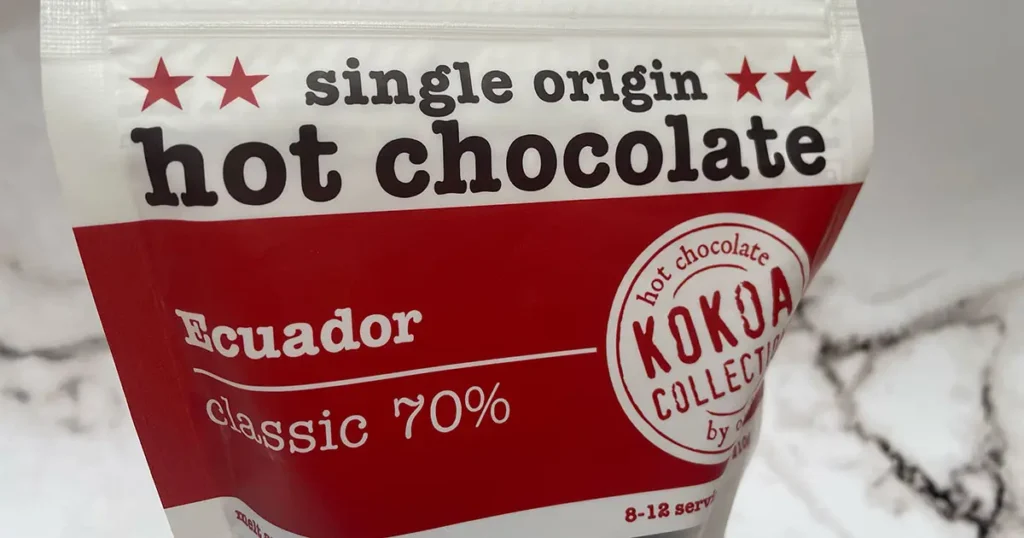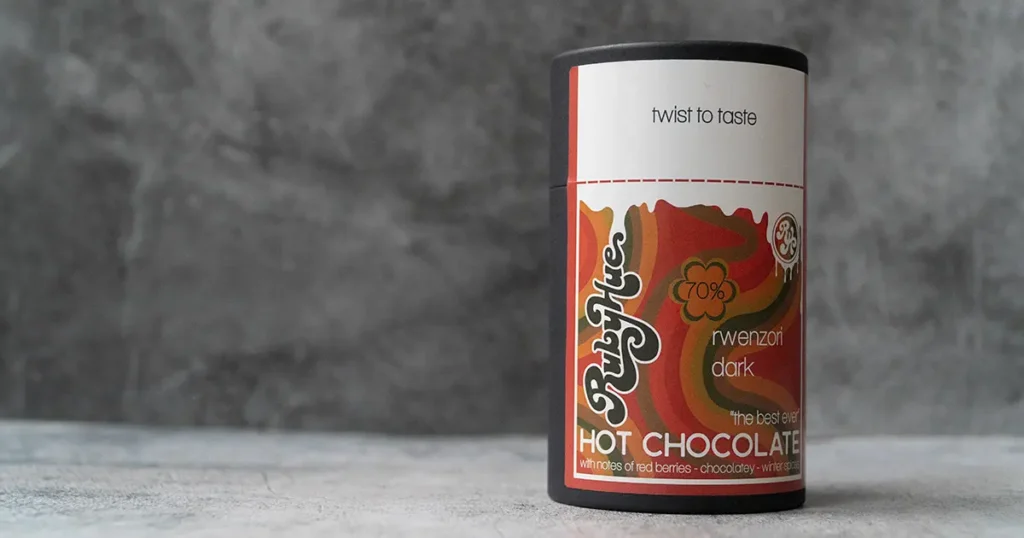Have you ever pondered the difference between cacao and cocoa powder while preparing a cup of hot chocolate? This article delves into the origins, processing methods, and nutritional profiles of these two key ingredients. Discover how each contributes uniquely to the flavour and health benefits of your favourite chocolatey drinks and learn how to choose the right powder for your creations.
Table of Contents
Cacao and Cocoa Powder: Unveiling the Differences
The rise in popularity of craft chocolate and premium hot chocolate has marked a significant shift in consumer preferences, moving away from traditional offerings to more sophisticated and varied chocolate experiences.
This shift has not only broadened our chocolate horizons but has also ignited a deeper interest in the fundamental components of chocolate beverages, specifically the powders that form their base: cacao and cocoa.
Understanding the Distinctive Qualities of Cacao and Cocoa
As we delve deeper into the chocolate industry’s heart, we confront a prevalent source of confusion – the distinction between cacao and cocoa powder.
Despite their similar origins, the divergence in their processing methods, flavour nuances, nutritional profiles, and culinary applications is substantial. A thorough understanding of these differences is crucial for anyone looking to deepen their appreciation of chocolate and make informed decisions that reflect their health objectives and taste preferences.
I’m hoping to demystify the contrast between cacao and cocoa powder, providing insights that could enhance the quality and enjoyment of your chocolate experiences.
Understanding Cacao and Cocoa Powder
Definition of Cacao Powder and Its Origins
Cacao powder, the less processed sibling in the chocolate family, is made by cold-pressing unroasted cacao beans. This method preserves the living enzymes in the cacao and retains its high nutritional value, making it a favourite among health enthusiasts.
Originating from the Theobroma cacao tree, which translates to “food of the gods,” cacao has been revered for centuries in various cultures for its rich taste and health benefits.
Definition of Cocoa Powder and How It Differs from Cacao
On the flip side, cocoa powder takes a slightly different journey.
After the cacao beans are roasted and processed at higher temperatures, they’re ground into a fine powder. This process gives cocoa powder its characteristic mellow flavour and makes it a staple in baking and hot chocolate recipes worldwide.
The key difference lies in the processing: the roasting of cacao beans alters their molecular structure, reducing the enzyme content and changing the flavour profile from bitter to a more subdued chocolatey taste.
The Historical Journey of Cacao to Cocoa
A Brief History of Cacao Cultivation and Its Significance in Ancient Cultures
Cacao’s journey begins in the ancient civilisations of Mesoamerica, where it was not only a cherished food item but also a currency and a key element in rituals.
The Aztecs and Mayans mixed ground cacao beans with spices to create a frothy, bitter beverage quite unlike the hot chocolate we know today. This deep-rooted cultural significance highlights the timeless allure of chocolate in its various forms.
The Evolution of Cacao into Cocoa Powder Through Modern Processing Techniques
The transformation of cacao into cocoa powder is a tale of culinary evolution, marked by the advent of modern processing techniques in the 19th century.
With the invention of the hydraulic press, which could separate cacao butter from the cacao mass, and the subsequent development of alkalisation by Coenraad Van Houten, cocoa powder became more accessible and palatable, paving the way for the widespread consumption of chocolate in solid and liquid forms.
Cultivation and Processing: From Bean to Powder
Explanation of How Cacao Beans Are Cultivated and Harvested
The cultivation of cacao beans is a delicate process that requires a specific climate and careful attention.
Cacao trees thrive in the warm, humid environments of the equatorial belt, with major production in countries like Ivory Coast, Ghana, Ecuador and across parts of the the Amazon. The beans are harvested from the cacao pods, fermented to develop their flavour, and then dried before undergoing further processing.
If you’re looking to explore the topic of wild chocolate and the obsessive lengths some chocolate makers will go to, I’d definitely recommend the Wild Chocolate podcast by Rowan Jacobson, which had me gripped from the first episode to the last.

Forget Willy Wonka and those heart-shaped Valentine’s boxes. OBSESSIONS: Wild Chocolate. is a totally different beast. Join host Rowan Jacobson as he elbows his way through the rain forest, crash lands into cocaine flyaways, and avoids a few too many anaconda, tagging along with modern-day Lara Crofts as they try to get their hands on some of the world’s most ancient– and expensive– cacao.
The Process of Turning Cacao Beans into Cacao Powder: A Closer Look
Preserving Nutrients and Flavours: The Raw Cacao Bean Approach
The journey of transforming cacao beans into cacao powder begins with a meticulous process that significantly impacts the nutritional value and flavour profile of the final product.
Unlike the method used to produce cocoa powder, the cacao beans undergo minimal processing to become cacao powder, ensuring the preservation of their natural properties and nutrients.
The crucial fermentation process
Initially, the harvested cacao beans are subjected to a crucial fermentation process. This step is essential for developing the beans’ complex flavours and reducing their inherent bitterness.
Fermentation involves allowing the beans to sit in their natural pulp for several days, during which natural yeasts and bacteria break down the sugars in the pulp. This not only enhances flavour but also initiates the development of key compounds that contribute to the health benefits of cacao.
After fermentation, the beans are carefully cleaned to remove any foreign matter and then dried.
Instead of being roasted, which is common in cocoa powder production, these beans are left raw. This crucial decision ensures that the beans do not undergo any heat-induced changes, preserving the integrity of their nutritional content and complex flavour.
The raw beans are then cold-pressed, a process that applies pressure to extract cacao butter while minimising heat generation. This stage is vital for maintaining the temperature-sensitive antioxidants and enzymes found in cacao.
From Cacao Cake to Nutrient-Rich Powder
The result of cold-pressing is a dense, cacao cake, which is devoid of the majority of its fat content but rich in nutrients and flavour. This cake is then ground into a fine powder.
The grinding process is carefully controlled to prevent heat buildup, which could compromise the powder’s nutritional value. The final product is a highly nutritious cacao powder, celebrated for its high levels of antioxidants, such as flavonoids, and minerals, including magnesium, iron, and zinc.
A Super Food?
These components contribute to the superfood status of cacao powder, offering various health benefits ranging from improved cardiovascular health to enhanced mood and cognitive function.
This careful and minimal processing method, starting from fermentation to cold-pressing, not only preserves the healthful qualities of the cacao bean but also contributes to the rich, complex flavour profile of cacao powder.
It’s this depth of flavour and nutritional richness that has led many to consider hot chocolate made with cacao powder not just a comforting drink but a healthy one as well. The presence of high antioxidant levels, in particular, supports the notion of hot chocolate as a beneficial addition to one’s diet, especially when cacao powder is used in its purest form, without added sugars or milk.
The Journey from Cacao Beans to Cocoa Powder
The Initial Roasting Phase
Enhancing Flavour Through Roasting
The production of cocoa powder sets itself apart from cacao powder with the initial step of roasting the cacao beans.
This crucial phase not only intensifies the beans’ inherent chocolate flavour but also facilitates the grinding process by making the beans more brittle.
Roasting is a carefully calibrated process, where temperature and time are adjusted to develop the desired flavour profile. This step significantly influences the final taste of the cocoa powder, bringing out a richer, more robust chocolate flavour that is characteristic of many chocolate products.
The Impact of Roasting on Nutritional Content
While roasting enhances the flavour of cacao beans, it’s important to note that this process can also affect their nutritional content. High temperatures may lead to a reduction in certain heat-sensitive nutrients, such as antioxidants.
However, roasted cocoa powder still retains a significant amount of minerals and remains a source of dietary fibre and protein, contributing to its nutritional value despite the loss of some antioxidants.
Pressing and Grinding: From Beans to Powder
Separating Fat from the Cocoa Mass
After roasting, the cacao beans are pressed, a step that separates the fat (cocoa butter) from the rest of the bean. What remains after this fat extraction is a solid mass known as a cocoa cake.
This pressing process is essential for producing both cocoa butter and cocoa powder, serving as a pivotal moment in the transformation of cacao beans into various chocolate products.
Grinding Cocoa Cake into Fine Powder
The cocoa cake is then ground into a fine powder. This grinding process is critical for achieving the smooth texture that cocoa powder is known for.
The fineness of the powder not only affects the mouthfeel of the final product but also its ability to mix well with other ingredients, making it ideal for baking and cooking applications.
The Alkalisation Process
Neutralising Acidity for a Milder Flavour
Some cocoa powders undergo an additional step known as alkalisation, or Dutch processing.
This method involves treating the cocoa powder with an alkaline solution to neutralise its natural acidity. The alkalisation process not only mellows the flavour of the cocoa powder, making it less bitter but also darkens its colour to a rich, deep brown.
This modification enhances the visual appeal of baked goods and other dishes, contributing to their enticing chocolatey appearance.
The Role of Alkalisation in Culinary Applications
Alkalised cocoa powder is particularly valued in the culinary world for its predictable flavour and colour. Its reduced acidity makes it more compatible with a variety of ingredients and recipes, ensuring consistent results in baking and cooking.
This versatility, combined with its appealing colour and milder taste, makes alkalised cocoa powder a preferred choice for chefs and home bakers aiming for perfectly chocolatey outcomes in their creations.
By understanding the comprehensive process that transforms cacao beans into cocoa powder, including roasting, pressing, grinding, and possibly alkalising, consumers and culinary enthusiasts can better appreciate the science and art behind their favourite chocolate-flavoured treats.
This knowledge not only enriches the culinary experience but also informs choices regarding the type of cocoa powder best suited to different dietary preferences and cooking or baking needs.
Taste and Culinary Uses
Description of the Taste Profile of Both Cacao and Cocoa Powder
Cacao powder boasts a robust, bitter flavour that’s rich in chocolatey notes, reflecting its minimal processing and preservation of the bean’s natural essence.
Cocoa powder, with its smoother and more mellow taste due to roasting and sometimes alkalisation, offers a more universally palatable chocolate flavour that’s beloved in desserts and hot beverages alike.
Suggestions for Using Cacao and Cocoa Powder in Hot Chocolate Recipes and Other Culinary Applications
The intense flavour of cacao powder shines in raw recipes, such as smoothies or energy balls, where its nutritional benefits can be fully appreciated. It can also add depth to hot chocolate, appealing to those who prefer a less sweet, more chocolate-forward taste.
Cocoa powder, on the other hand, is the go-to choice for traditional hot chocolate recipes, offering a comforting, classic chocolate taste that pairs wonderfully with milk and sweeteners. Its versatility also extends to baking, where it’s used to create everything from moist cakes to rich brownies.
Health Benefits and Considerations
The Health Benefits Associated with Consuming Cacao and Cocoa Powder
Cacao powder is celebrated for its high content of antioxidants, magnesium, and iron, contributing to heart health, improved mood, and overall well-being.
Cocoa powder, while slightly lower in these nutrients due to processing, still offers significant health benefits, including supporting heart health and providing essential minerals.
Potential Health Considerations and Advice on Moderate Consumption
While both cacao and cocoa powders are beneficial in moderation, it’s important to be mindful of the caffeine content and potential for added sugars in some processed cocoa powders.
Choosing unsweetened powders and enjoying them as part of a balanced diet can help maximise their health benefits without overindulging.
Selecting the Best Quality Powder for Your Hot Chocolate
Tips on Choosing High-Quality Cacao and Cocoa Powders for Hot Chocolate
In the pursuit of crafting the ultimate cup of hot chocolate, the selection of cacao or cocoa powder is paramount.
For aficionados of bean-to-bar and craft chocolate, this choice transcends mere taste, embodying principles of ethics and sustainability.
Premium powders, exemplified by brands like Marou Chocolate, distinguish themselves through exceptional flavour profiles and a steadfast commitment to ethical production practices.

Prioritising Purity in Ingredients
A key strategy in selecting your chocolate powder involves opting for products that boast minimal ingredients.
This approach ensures that you’re getting a product that allows the authentic chocolate flavours to dominate your hot chocolate.
Many of the renowned craft chocolate producers deliver on this by offering a cacao powder that’s devoid of unnecessary additives, ensuring a pure, unadulterated chocolate experience.
The Significance of Ethical Sourcing and Organic Certification
The journey towards enjoying a rich and ethically produced cup of hot chocolate involves more than just selecting a high-quality powder; it’s about understanding and supporting the practices behind bean-to-bar and craft chocolate production.
Supporting Sustainable and Fair Practices
Ethical sourcing is a cornerstone of the bean-to-bar chocolate philosophy, ensuring that cacao farmers receive fair compensation for their work.
This not only aids in preserving traditional farming techniques but also promotes the well-being of farming communities. Organic certification further signifies a commitment to growing cacao without harmful pesticides or chemicals, contributing to the health of both the consumer and the planet.
Conclusion
In conclusion, the choice of cacao or cocoa powder for your hot chocolate is a decision that extends beyond taste.
It’s an opportunity to support the bean-to-bar and craft chocolate industry. By making informed selections, consumers can indulge in a superior hot chocolate experience that satisfies the palate and the conscience, fostering a positive impact on the global chocolate industry.
As we’ve journeyed through the world of cacao and cocoa powders, it’s clear that both have their unique charms and uses in the kitchen.
Understanding the differences between them not only enhances our culinary creations but also allows us to appreciate the rich history and careful processing behind each cup of hot chocolate.
Whether you lean towards the robust intensity of cacao or the comforting familiarity of cocoa, there’s no denying the joy that a well-made hot chocolate can bring.
So, armed with this knowledge, why not experiment with both and discover your perfect blend?





